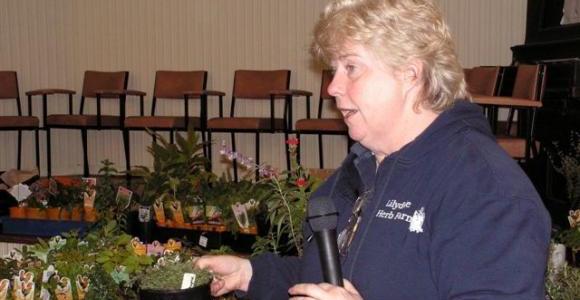
Cultivation and uses of herbs
You are here

Lynne McCall has over a thousand varieties of herbs at her Lilydale Herb Farm. Lynne came across the farm on her birthday two years ago, when it was about to close down. Lynne took us through some of the herbs used for medicinal and culinary purposes. Herbs are easy to grow and use – they are the weeds that were kept alive through the ages because of their value. Sage is one of the oldest – it belongs to the salvia family, which are very hardy and easy to grow. In the Roman Days, they were known as ‘the medicine chest’. Some are known to have mystical qualities and are used in South America in rituals. Sage tea is great for a cold or fever – just steep a few leaves in hot water. Rosemary has only two species, and about three different sub-species – its name means ‘Rose of the Sea’. Rosemary grows above sea level in the Mediterranean. They are used to surviving on sea spray, so don’t over water.
The flowers can be white, pink or blue. They will get spindly if you don’t cut them back – you can prune them any time of the year. Thyme varieties are more complex and they also originate in the Mediterranean. They can be upright or creeping, not all are edible. Edible lawns can be grown from creeping thyme, lawn chamomile or Corsican moss. They’re great as they don’t require mowing and provide a wonderful fragrance to the garden. There are six major species of lavender; the main ones we know are the English (classic pyramid shape), which are edible. Don’t overwater or you won’t get the flowers or scent – the roots don’t like to get too wet. There is also French lavender – dentate – with the fairy wings at the top of the flowers and leaves that look like feathers. Spanish lavender has a slightly different flower head. Medicinal properties are similar to sage but only the English lavender is edible. Lavender oil can be used to soothe and relax, great for teething babies and unwinding.
Pennywort is known as the arthritis herb and is very easy to propagate. The leaves can be added to mashed potato or made into tea.
Gotu Kola is the Asian species of pennywort, with similar medicinal properties, but stronger and broader, especially the Sri Lankan variety, which has been used in Tamil medicine for years. Brahmi is known as the memory herb, which has a powerful effect on memory, due to the essential oils it contains and has a lovely flavour, but needs to be used raw. Angelica is easy to grow and is used to make green decorations for cakes when candied. Migration has increased the range of herbs available. Herb Robert is a true geranium and has pretty pink flowers; it likes a similar environment to maidenhair ferns. It’s Lynne’s biggest selling plant as is used in treatment for cancer, particularly cancer of the reproductive system. Two fresh leaves are added to a tea made from the dried herb. Coriander and tarragon are great to cook with and add a lot of flavour although they don’t last long as they’re annuals. Plant them intermittently to ensure supply, although perennial varieties are now available.
When planting, touch the roots or seeds with your hands so that they pick up the oils from your skin – you can even add your saliva. This helps them to respond to your own environment. Stevia originated in warm climates, so requires some shelter – even a soft drink bottle can be used for protection. It’s a sugar-based plant and is used for sweetening as it’s much sweeter than sugar, and is therefore suitable for diabetics.
Neme trees are known as the Indian Marriage trees – they are used as an insecticide.
Possums hate Quassia bark – you purchase some dried bark, mix with water and spray to deter them.
Violets, including native violets are edible and great for digestive upsets; both the flower and younger leaves can be eaten.
Nasturtium flowers and leaves can be eaten – it has quite a ‘bit’ to it and adds a peppery taste to food. Again, eat the younger leaves.
There are three main types of basil including the annual variety and the perennial and sacred varieties. Lynne explained that our cool and dark summer was not ideal for some of her herbs.
Lynne doesn’t use pesticides or chemicals at her farm and intends to get a beehive to use the honey in the restaurant at the farm. She uses organic potting mix and repots the herbs every year. Herbs prefer to be in the garden rather than in pots. She uses Dynamic Lifter to fertilise and uses white cloth to allow them enough light – in general they prefer full sun.
Lynne advises to taste the leaves of herbs before purchasing, to make sure they are the variety you seek. We need to be very responsible with the use of certain herbs such as Vietnamese mint, which can be very invasive and can clog waterways; for this reason, some plants have been banned from growing in Victoria.
For a delicious seven-herb omelette, use rosemary, sage, parsley, silver thyme, coriander, chives and Lebanese cress.








